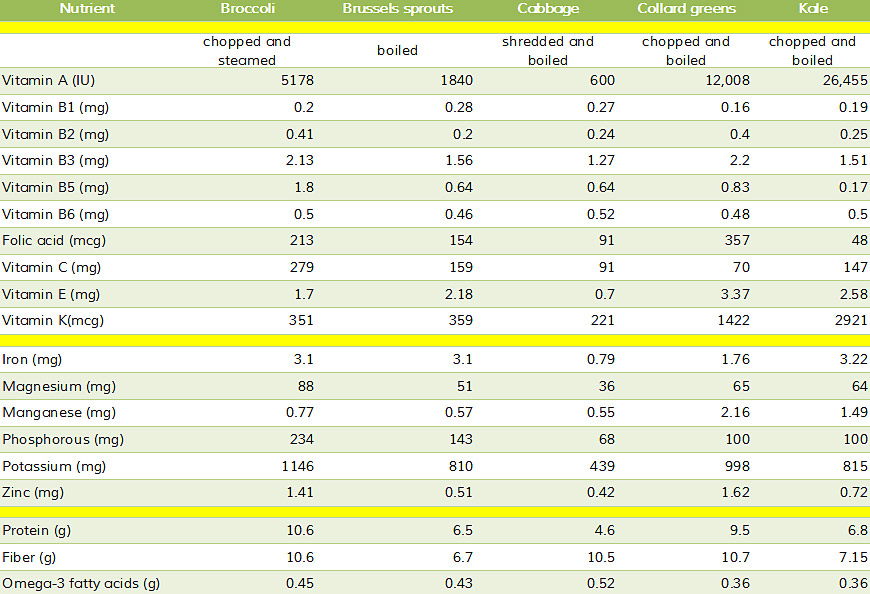Lately cruciferous vegetables have become the subject of many studies and have proven to be the superfoods group like no other. Cruciferous vegetable group integrates a wide range of nutrients that is broader than any other single food group subdivision. The nutrient content of this group will blow your mind.
Cruciferous Vegetables | The Superfoods Group
There is no other vegetable group that is as high in vitamin A carotenoids, vitamin C, folic acid, and fiber as the cruciferous vegetables.
The vitamin K content in cruciferous vegetables, especially kale and collards, has been the subject of research studies over the past five years on cancer and inflammation. Vitamin K regulates our inflammatory response, including chronic responses that can increase the risk of certain cancers.
Cruciferous vegetables group can also be dubbed as the antioxidant vegetable group because of their high concentration of vitamin A carotenoids, high content of vitamin C and manganese!
Many B-complex vitamins are highly concentrated in these plants, as are certain minerals.
But this superfoods group does not stop there. That would be way too usual for these unusual guys. The have the bragging rights when it comes to fiber, protein and healthy fats content too!
Only 100 calories of cruciferous vegetables provides a whopping 25-40% of our daily fiber requirement! When it comes to protein, you get over 25% of the DV in just 3 cups, with a low calorie content. 200 calories of steamed broccoli will yield 20 grams of protein!
100 calories of cruciferous vegetables yields between 1/3-1/2 a gram of omega-3 fat (333-500 milligrams). This omega-3 fat comes primarily as ALA (alpha-linolenic acid), which serves as the basic building block for all other forms of omega-3 fats in the body. There is far more ALA in 100 calories of cabbage than there is in 100 calories of salmon! The amount of total omega-3s in 100 calories of cabbage is 520 milligrams!
However, cruciferous vegetable have even more boasting to do. They have something that no other plant group can boast about. The group contains its own unique set of phytonutrients — the glucosinolates — that are simply unavailable to the same extent in any other food group.
Nutrient Content of Cruciferous Vegetables
(amounts per 100 calories of each vegetable)
Cruciferous Vegetables | Meet Your Super Heroes
- Arugula
- Bok choy
- Broccoli
- Brussels sprouts
- Cabbage
- Cauliflower
- Chinese cabbage
- Collard greens
- Daikon radish
- Horseradish
- Kale
- Kohlrabi
- Land cress
- Mustard greens
- Radish
- Rutabaga
- Shepherd’s purse
- Turnip
- Watercress
as well as spices and seeds made/come from these plants.
Very Special Properties
In the last decade cruciferous vegetables have been studies for their phytonutrients. Glucosinolates, which are simply unavailable to the same extent in any other food group have become the focus in the world of research. Scientists have now identified over 100 different glucosinolates in food, most of which can only be found in the cruciferous group.
Why are glucosinolates so special? The research has shown that they are important in cancer prevention and treatment. These phytochemicals stimulate the production of enzymes in the body that detoxify carcinogens before they have a chance to damage cells. During food preparation, chewing, and digestion, the glucosinolates in cruciferous vegetables are broken down to form biologically active compounds such as indoles, nitriles, thiocyanates, and isothiocyanates. Indole-3-carbinol and sulforaphane have been most frequently examined for their anticancer effects. Indoles and isothiocyanates have been found to inhibit the development of cancer in several organs, including the bladder, breast, colon, liver, lung, and stomach. There are several ways in which these compounds help to prevent and fight cancers. They:
- protect cells from DNA damage
- inactivate carcinogens
- have antiviral, antibacterial and anti-inflammatory effects
- induce cell death, known as apoptosis
- inhibit tumor blood vessel formation (angiogenesis) and tumor cell migration (needed for metastasis)
Cruciferous vegetables are also great for our health. The phytochemicals in them assist in detoxification of estrogen from our system.
According to a recent study, women diagnosed with breast cancer who include cruciferous vegetables in their diets may live longer than those who do not consume these foods.
Researchers looked at data from 4886 Chinese breast cancer survivors from 2002 to 2006. Women who consumed increased amounts of cruciferous vegetables within the first 36 months after their diagnosis had a higher survival rate than breast cancer survivors who did not eat more of these foods. (7)
Scientific Findings
While many cultures, including mine, have pleasurably consumed cruciferous vegetables for thousands of years, you know that the science always wants to see charts and graphs to be convinced that plants are truly miraculous. So, I am going to quote a few studies which have proven just that.
Cruciferous vegetables intake was related to the decreased risk of bladder cancer. (1)
High intake of cruciferous vegetables was inversely associated with the risk of CRC and colon cancer in humans. (2)
An isothiocyanate, found in cruciferous vegetables, possesses antitumor activities. (3)
A phytonutrient and plant indole found in cruciferous vegetables including broccoli, Brussels sprouts, cabbage, cauliflower and kale, with anti-androgenic and antineoplastic activities. As a dimer of indole-3-carbinol, diindolylmethane (DIM) promotes beneficial estrogen metabolism in both sexes, resulting in increased antioxidant activity. (4)
A naturally-occurring phytochemical belonging to the class of isothiocyanates, sulforaphane acts as an antioxidant and potent stimulator of endogenous detoxifying enzymes. This agent displays anticarcinogenic properties due to its ability to induce phase II detoxification enzymes, thereby providing protection against certain carcinogens and toxic, reactive oxygen species. Broccoli sprouts contain large amounts of sulforaphane, which is also found in other cruciferous vegetables including cabbage and kale. (5)
A study found that intake of legumes and yellow-orange and cruciferous vegetables was associated with a lower risk of prostate cancer. (6)
A review study conducted at George Mason University of 8 observational studies and 17 intervention or laboratory trials that examined the relationship between a plant-based diet and prostate cancer. The article reported that the highest rates of prostate cancer occur in Sweden and the U.S., while the lowest rates are in China and India. The researchers concluded, “In large population studies performed in over 60 countries, as well as in prospective cohort studies, intake of dairy products, red meat, and total dietary fat, have been found to be positively correlated with increased risk of prostate cancer. In contrast, consumption of soy products, fiber-containing foods, cruciferous vegetables and lycopene have been reported to be inversely associated with prostate cancer risk. These studies suggest that predominantly plant-based diets that are high in fiber and phytonutrients and low in fat and saturated fat, favorably influence health outcomes for prostate cancer patients.” (8)
In a 25-year study of 13,000 women, researchers at Harvard Medical School found that those women who ate high amounts green leafy and cruciferous vegetables had less decline in memory as they aged. Women who consumed the highest amounts—1.5 daily servings of green leafy vegetables and 1 daily serving of cruciferous vegetables—benefited the most. (9)
Men who eat more cruciferous vegetables have a lower risk for prostate cancer. DIM, a naturally occurring chemical in cruciferous vegetables, caused prostate cancer cells to grow 70% more slowly in a test tube than untreated cells. (10).
Whole Foods NOT Extracts!
As with everything, once we find a good thing, we tend to think that if we isolate it, and get a whole lot of it, we will get a better results faster. But we all know that the whole is always better than its parts.
The objective of one study was to determine the efficacy of consuming nutrients from cruciferous vegetables in supplement form. Cruciferous vegetables contain glucosinolates which are metabolized by the body into isothiosynates, which include suforaphane and erusin. The study showed that the broccoli supplements did not function the same way as the whole food.
Emily Ho at Oregon State University, was the lead researcher, stated, “…the particular compounds we believe give broccoli and related vegetables their health value need to come from the complete food.” (11)
Not a Magic Pill
It is also important to understand that one serving of broccoli, as a part of a poor diet, will not make a dent in your poor health. If your diet is rich in nutrient deficient, processed, junk foods, as is true with the Standard American Diet (SAD), there is little hope of relying on the super food qualities of cruciferous vegetables. The entire diet needs to be based on whole foods, excluding as much junk as possible, to be beneficial.
Ways to Enjoy Cruciferous Vegetables
Now that you are convinced that cruciferous vegetables are a super food group and good, not bad for you (I will have a separate post on goiterogenic myth of certain foods), you need to make sure to have a regular helping of them. Here are a few ways you can enjoy them.
Raw, due to enzyme activity in the raw foods, is always optimal and desirable. You can make smoothies with kale, collard greens, radish greens and bok choy greens. Make salads with arugula, bok choy, radishes and cabbage.
You can ferment cruciferous vegetables and get even more bang for your buck–you will get the enzyme activity and good bacteria (nature’s probiotic).
Cooked vegetables can also be delightful and very beneficial. Make soups with cabbage, steam broccoli and other veggies, make baked Cauli Poppers out of cauliflower, and water saute your Brussels.
The possibilities are endless.
Your Favorite Cruciferous Vegetables
I can hardly go a week without eating cabbage, kale, radishes and cauliflower (which was not always my favorite food). What are some of your favorite cruciferous veggies, and the ways you prepare them?
Share
Please remember to share this article with everyone you care about. Help them to improve their health. Social share buttons are at the top, bottom and to the side of this post.
References
- http://www.ncbi.nlm.nih.gov/pubmedhealth/PMH0058505/
- http://www.ncbi.nlm.nih.gov/pubmedhealth/PMH0056398/
- http://www.ncbi.nlm.nih.gov/medgen/33016
- http://www.ncbi.nlm.nih.gov/medgen/58034
- Kolonel LN, Hankin JH, Whittemore AS, et al.: Vegetables, fruits, legumes and prostate cancer: a multiethnic case-control study. Cancer Epidemiol Biomarkers Prev 9 (8): 795-804, 2000.
- Shu Xiao Ou, Nechuta, S, Lu, Wei. “Cruciferous vegetable consumption linked to improved breast cancer survival rates.” American Association for Cancer Research
- Berkow, Susan et al, “Diet and survival after prostate cancer diagnosis” Nutrition Reviews vol 65 #9
- http://hms.harvard.edu/sites/default/files/HMS_OTB_Winter12_Vol18_No1.pdf
- Schaldach et al, “Plant-derived DIM is a strong androgen antagonist in human prostate cancer cells” J Biol Chem 2003;278:21136-45
- Clarke JD, Ried K, Bella D et al. “Comparison of Isothiocyanate Metabolite Level and Histone Deacetylase Activity in Human Subjects Consming Broccoli Sprouts or Broccoli Supplement.” Journal of Agricultural and Food Chemistry Published online ahead of print Doi: 10.1021/jf20287g

